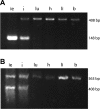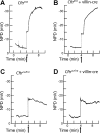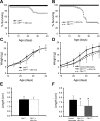Cystic fibrosis growth retardation is not correlated with loss of Cftr in the intestinal epithelium
- PMID: 21659619
- PMCID: PMC3174541
- DOI: 10.1152/ajpgi.00052.2011
Cystic fibrosis growth retardation is not correlated with loss of Cftr in the intestinal epithelium
Abstract
Maldigestion due to exocrine pancreatic insufficiency leads to intestinal malabsorption and consequent malnutrition, a mechanism proposed to cause growth retardation associated with cystic fibrosis (CF). However, although enzyme replacement therapy combined with increased caloric intake improves weight gain, the effect on stature is not significant, suggesting that growth retardation has a more complex etiology. Mouse models of CF support this, since these animals do not experience exocrine pancreatic insufficiency yet are growth impaired. Cftr absence from the intestinal epithelium has been suggested as a primary source of growth retardation in CF mice, a concept we directly tested by generating mouse models with Cftr selectively inactivated or restored in intestinal epithelium. The relationship between growth and functional characteristics of the intestines, including transepithelial electrophysiology, incidence of intestinal obstruction, and histopathology, were assessed. Absence of Cftr exclusively from intestinal epithelium resulted in loss of cAMP-stimulated short-circuit current, goblet cell hyperplasia, and occurrence of intestinal obstructions but only slight and transient impaired growth. In contrast, specifically restoring Cftr to the intestinal epithelium resulted in restoration of ion transport and completely protected against obstruction and histopathological anomalies, but growth was indistinguishable from CF mice. These results indicate that absence of Cftr in the intestinal epithelium is an important contributor to the intestinal obstruction phenotype in CF but does not correlate with the observed growth reduction in CF.
Figures








Similar articles
-
Growth deficits in cystic fibrosis mice begin in utero prior to IGF-1 reduction.PLoS One. 2017 Apr 6;12(4):e0175467. doi: 10.1371/journal.pone.0175467. eCollection 2017. PLoS One. 2017. PMID: 28384265 Free PMC article.
-
Intestinal bicarbonate secretion in cystic fibrosis mice.JOP. 2001 Jul;2(4 Suppl):263-7. JOP. 2001. PMID: 11875269
-
Cystic fibrosis mouse model-dependent intestinal structure and gut microbiome.Mamm Genome. 2015 Jun;26(5-6):222-34. doi: 10.1007/s00335-015-9560-4. Epub 2015 Feb 27. Mamm Genome. 2015. PMID: 25721416 Free PMC article.
-
The cystic fibrosis intestine.Cold Spring Harb Perspect Med. 2013 Sep 1;3(9):a009753. doi: 10.1101/cshperspect.a009753. Cold Spring Harb Perspect Med. 2013. PMID: 23788646 Free PMC article. Review.
-
Cystic fibrosis and fat malabsorption: Pathophysiology of the cystic fibrosis gastrointestinal tract and the impact of highly effective CFTR modulator therapy.Nutr Clin Pract. 2024 Apr;39 Suppl 1:S57-S77. doi: 10.1002/ncp.11122. Nutr Clin Pract. 2024. PMID: 38429959 Review.
Cited by
-
Intestinal smooth muscle dysfunction develops postnatally in cystic fibrosis mice.J Pediatr Gastroenterol Nutr. 2012 Dec;55(6):689-94. doi: 10.1097/MPG.0b013e3182638bf4. J Pediatr Gastroenterol Nutr. 2012. PMID: 22699839 Free PMC article.
-
New animal models of cystic fibrosis: what are they teaching us?Curr Opin Pulm Med. 2011 Nov;17(6):478-83. doi: 10.1097/MCP.0b013e32834b14c9. Curr Opin Pulm Med. 2011. PMID: 21857224 Free PMC article. Review.
-
Improved Growth Patterns in Cystic Fibrosis Mice after Loss of Histone Deacetylase 6.Sci Rep. 2017 Jun 16;7(1):3676. doi: 10.1038/s41598-017-03931-2. Sci Rep. 2017. PMID: 28623308 Free PMC article.
-
Intestinal CFTR expression alleviates meconium ileus in cystic fibrosis pigs.J Clin Invest. 2013 Jun;123(6):2685-93. doi: 10.1172/JCI68867. Epub 2013 May 8. J Clin Invest. 2013. PMID: 23676501 Free PMC article.
-
CFTR dysregulation drives active selection of the gut microbiome.PLoS Pathog. 2020 Jan 21;16(1):e1008251. doi: 10.1371/journal.ppat.1008251. eCollection 2020 Jan. PLoS Pathog. 2020. PMID: 31961914 Free PMC article.
References
-
- Aris RM, Guise TA. Cystic fibrosis and bone disease: are we missing a genetic link? Eur Respir J 25: 9–11, 2005 - PubMed
-
- Arumugam R, LeBlanc A, Seilheimer DK, Hardin DS. Serum leptin and IGF-I levels in cystic fibrosis. Endocr Res 24: 247–257, 1998 - PubMed
-
- Bijvelds MJ, Bronsveld I, Havinga R, Sinaasappel M, de Jonge HR, Verkade HJ. Fat absorption in cystic fibrosis mice is impeded by defective lipolysis and post-lipolytic events. Am J Physiol Gastrointest Liver Physiol 288: G646–G653, 2005 - PubMed
-
- Bjerknes M, Cheng H. Methods for the isolation of intact epithelium from the mouse intestine. Anat Rec 199: 565–574, 1981 - PubMed
Publication types
MeSH terms
Substances
Grants and funding
LinkOut - more resources
Full Text Sources
Other Literature Sources
Medical
Molecular Biology Databases

